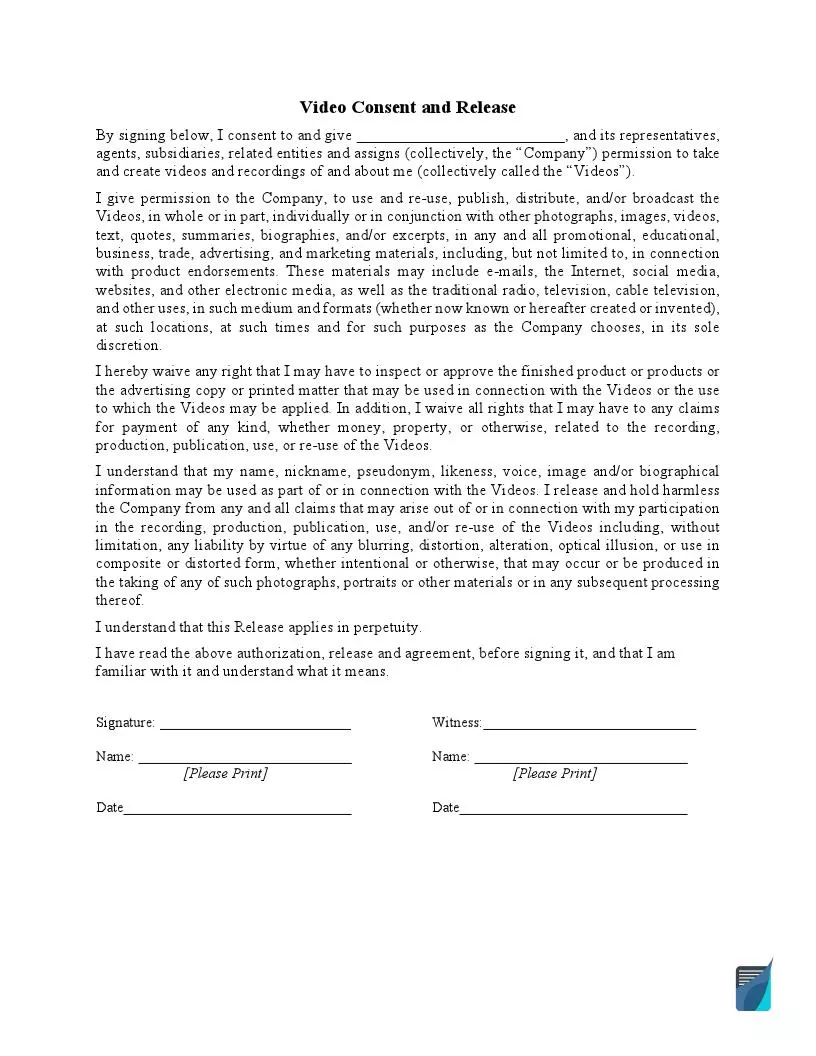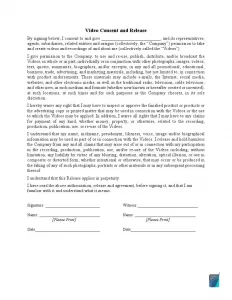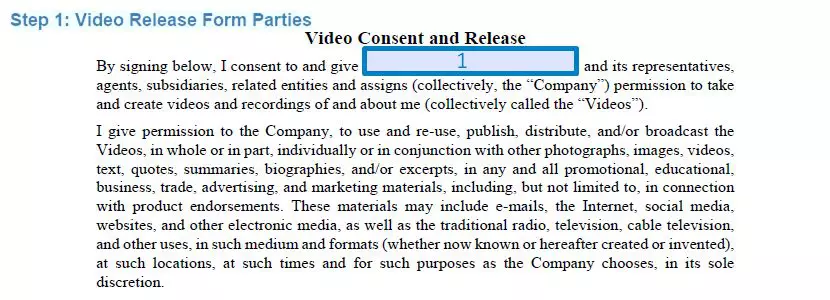Video (Film) Release Form
A video release form, sometimes known as a video consent form, is an enforceable document designed to confirm the participants’ consent to be recorded on video. This release of liability form ensures that the person is aware of being recorded and agrees to their images and sound recording usage.
A video consent form is a good way to make sure that nobody will cancel the video’s participation and that nobody appearing in the video will decide to sue the production company (or other entity making the video). Therefore, it’s critical to include every single detail of legal information in the form to protect your video footage. Our video release form template will help you create the document as comprehensively as possible, and our guidelines will easily walk you through the writing process.

Build Your Document
Answer a few simple questions to make your document in minutes
Save and Print
Save progress and finish on any device, download and print anytime
Sign and Use
Your valid, lawyer-approved document is ready
Why It Is Reasonable to Use a Video Release Form
Imagine that you’ve prepared a scenario, found the participants and location, and started the production. But at the very last minute, someone refuses to participate. Or, imagine that you’ve already made the video, and one of your talents decides that it’s inappropriate for their name to be in it. In that case, you will probably need to look for another person to participate in the video, start over the production, or cut some parts out of the video. Thus, you are likely to waste both time and money. Even if the person verbally agrees to participate, it’s important to get the written consent form to avoid future misunderstandings or cancellations. So, consent forms are reasonable to use due to the following points:
- Signing a consent form, a person confirms the participation with no options and gives irrevocable permission to use their images and sound recordings.
- You can describe all the details related to the video footage in the release form, such as third-party involvement and compensation issues.
- With a consent form, a production entity outlines the ownership rights and how the video footage will be used in the future.
Video Release Form Details
| Document Name | Video Release Form |
| Other Names | Film Release, Video Production Release |
| Avg. Time to Fill Out | 5 minutes |
| # of Fillable Fields | 7 |
| Available Formats | Adobe PDF |
How to Work with a Video Release Form
You should approach the process of the release form creation step-by-step. First, it’s necessary to check the federal and state recording laws since there can be some specifications. As a general rule, the production company has to always obtain the consent of everyone who is being recorded, especially for commercial purposes. You are encouraged to follow the next steps when obtaining the participants’ permission to be recorded.
Step 1. Explain the expectations
It’s important to set clear expectations for all the video participants, including production time and when the edit will be ready. You need to explain why you are doing this project and why you want the participants to sign the consent form. Of course, if your talents work in the sphere for a long time, they will probably understand the purpose and need for such a document. But for the one who’s being recorded for the first time, waiving their rights can be a bit scary. Try to be as enthusiastic as possible and explain everything in detail.
Step 2. Prepare the form
After ensuring everyone is ready to become a part of the video, you should prepare your document. It’s necessary to use the correct structure and format. You are expected to highlight the essential information, such as compensation provision, time limits for the release, and the ownership rights. You should emphasize the need to pay attention to that information.
Step 3. Obtain the permission
When the document is ready, it’s time to obtain permission officially. Make sure that every participant reads the document carefully and understands it. You should get consent from everyone participating in the production if you don’t want to start over just because one of them has decided to quit.
What Components a Video Release Form Should Include
When preparing your release form, you should not rush and think over every detail. You are recommended to consider both present and future uses of the materials and include all this legal information in your document. Even if you’re in doubt of including certain provisions, it’s better to include them to avoid future misunderstandings. Video release forms usually contain the following information.
- Media to be used. As it’s a video release form, the person usually consents to not only usage of their image sequences but also the sound recording and still images too.
- Description of the event or activity. The form usually describes the event or activity to occur and the circumstances under which the video will be recorded.
- Purpose of the video material. The video release form should always include the purpose of the video recording. It can be commercial to promote or sell something and get a monetary profit from the created content, and non-commercial, for example, for educational or artistic use.
- Possible compensation. The video release form may provide compensation for the participant or no compensation at all, generally, in cases when the video is used for non-profit purposes.
- Third-party involvement. You should explain in your document whether the third parties are allowed to use your material and how they can do that.
- Effective date, participant’s name, and signature. As with every legal document, the release form includes the date when it becomes enforceable and the participant’s signature along with the contact information.
- Parent or guardian signature. In case minors participate in the video recording, the parent or legal guardian should assume the risks on behalf of them and then sign the release form.

Filling Out the Video Release Form
A video release form is easy and quick to prepare. Using our template, you will have all necessary components included and the appropriate structure. You are only expected to fill in the most important information, following the next steps.
Step 1. Identify the parties
Each party to the release form should be identified. You should name your production company (or other entity) at the beginning of the document. It’s necessary to include all your relevant contact information. The name and contact information of the participant is usually included in the end.

Step 2. Describe the project
The next step is to describe the overall project and the circumstances under which the video will be recorded. Listing circumstances and defining expectations allow you to inform the participants and cover your back in case of trouble.
Step 3. Indicate the purpose
You need to explain the purpose of your project—whether it’s commercial or non-commercial, for example, for educational use. The participants should understand from the beginning how the footage will be used and where it will be shown.
Step 4. Define the compensation
A release form should contain provisions explaining whether there will be compensation and, if yes, what kind of compensation the participants will get. Generally, in the case of commercial production, the compensation is monetary. However, if the footage is used for educational or artistic purposes, compensation is usually not provided.
Step 5. Get the signature
Both the participant and the company should carefully reread all the provisions, and if everything is okay, the video participants should sign the form. Do not forget to indicate the participant’s name and document’s date. It’s also necessary to indicate whether a parent or legal guardian signs the form (if minors participate in the event).

Frequently Asked Questions
When Should I Get the Form Signed?
If you want to invite someone to participate in your video, you should get these people’s signatures before the video production begins. That is how you can be sure that no one will change their mind in the most inconvenient moment. So, try to get the participant’s consent as soon as possible to avoid wasting time and money. If you’ve already recorded the person and want to use the video for commercial purposes, you can ask to sign the release form to use or make it publicly available.
Can Anyone Revoke the Consent to Use the Video or Images with Their Participation?
In most cases, it’s impossible to revoke the consent unless the release form allows them to. The majority of production companies provide the concept of irrevocability in the release forms. Thus, if someone signs the consent form, they cannot rescind it. However, the form can include the possibility of discontinuing involvement in the project or activity before or during the video production. In rare cases, the form provides the possibility to rescind the consent after the production is complete, but only if this decision is reasonable considering the financial and administrative costs. Nonetheless, the participant can revoke the consent in case of a breach, for example, if the production company has not provided the third-party involvement in the form but allowed others to use the video.